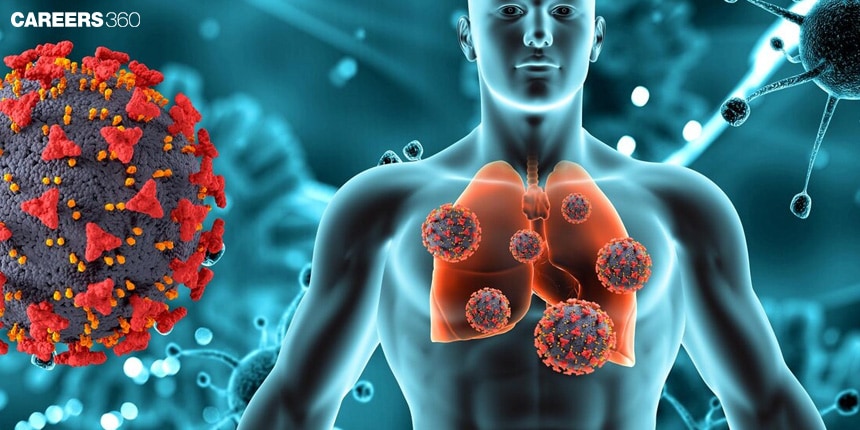Disorders Of The Respiratory System: Symptoms And Function
Respiratory disorders are conditions that act upon the respiratory system: lungs, airways, and related structures. The best-known respiratory diseases are asthma, bronchitis, pneumonia, and chronic obstructive pulmonary disease (COPD), which result from infections, allergies, smoking, or environmental influences. These conditions typically cause breathing difficulties, insufficient oxygen supply, and inflammation of the airways. This is part of the Breathing and Exchange of Gases chapter in Biology.
NEET 2025: Mock Test Series | Syllabus | High Scoring Topics | PYQs
NEET Important PYQ's Subject wise: Physics | Chemistry | Biology
New: Meet Careers360 B.Tech/NEET Experts in your City | Book your Seat now
- What are Respiratory System Disorders?
- Factors affecting respiratory system disorders
- Types of Respiratory System Disorders
- Causes of Respiratory Disorders
- Respiratory Disorders

What are Respiratory System Disorders?
Respiratory system disorders are various diseases wherein the airways, lungs, and associated structures are affected, making breathing difficult. The disorders can be a result of acute infections or chronic conditions that result in respiratory impairment. The formation and degree of many of these disorders are environmentally induced, related to lifestyle and choices for work.
Also Read:
Factors affecting respiratory system disorders
Factors that can lead to the first development or further deterioration of respiratory disorders include:
Genetic risk: Some respiratory conditions are completely genetic and one is born with them due to family history.
Allergies: Allergic reactions can trigger or aggravate respiratory issues.
Smoking: Tobacco smoking is a significant risk to many lung diseases.
Air Pollution: Exposure to air pollutants can result in respiratory problems.
Infections: Bacterial and viral infections can trigger or aggravate respiratory conditions.
Types of Respiratory System Disorders
There are two primary categorizations of respiratory disorders: upper and lower respiratory disorders.
Upper Respiratory Disorders
These diseases affect the nose, throat, and sinus and are often either viral or bacterial. These are some of the common ailments:
Common Cold: These are considered a viral infection which are marked with a blockage of the nose and a runny nose, at times, with a sore throat.
Sinusitis: This is infection of the sinuses resulting from infections or even from allergies. This ailment is marked by face pain and blockage.
Pharyngitis: Inflammation of the throat leading to discomfort, dysphagia, and sometimes raised temperature.
Lower Respiratory Disorders
These disorders only affect the lungs and bronchial tubes and they include chronic conditions and infections:
Asthma: This is a chronic inflammatory condition of the airways causing wheezing, shortness of breath, and coughing. It is usually triggered by allergens or irritants.
COPD: It is a progressive lung disease including chronic bronchitis and emphysema with airway obstruction and difficulty in breathing.
Pneumonia: It is an infectious disease of the lungs, caused by a Contagious infection characterized by fever, productive cough, and difficulty breathing.
Causes of Respiratory Disorders
Respiratory disorders can be caused due to a variety of issues, such as:
Infections: It is caused due to bacterial and viral infections.
Allergies: Allergens can act as causative agents and can trigger respiratory symptoms.
Smoking: Tobacco smoke is a major risk factor for several respiratory diseases.
Environmental Factors: Respiratory difficulties may result from air pollution and occupation-related exposure.
Respiratory Disorders
Following are some of the more common respiratory disorders:
Asthma: It is a respiratory disorder marked by wheezing, breathlessness, chest tightness, and cough, which typically occurs in response to allergens or physical exertion.
COPD: It is a serious disorder characterized by chronic difficulty in breathing. It is usually caused through long-term exposure to irritating gases or particulate matter.
Pneumonia: It is usually treated with antibiotics in cases caused by bacteria. In cases of viral pneumonia, supportive care is often adequate.
Chronic bronchitis: A type of COPD associated with the chronic production of cough and mucus, usually not reversible but amenable to treatment.
Sinusitis: Inflammation of the sinuses causing facial pain and congestion, different from a cold in its symptoms and duration.
Also Read
Frequently Asked Questions (FAQs)
Asthma is a chronic disease associated with wheezing at breathing, breathlessness, tightness in the chest and cough; it's often precipitated by allergens or exercise.
Antibiotics in cases of bacterial infections; however, in most cases, they only require rest, fluids, and support the relieving symptoms.
Abstaining from smoking, avoiding pollutants, good hygiene practices, and updated vaccinations decrease the rates of respiratory infections.
No, in general, though medications and pulmonary rehabilitation may relieve its symptoms at least partially. With time, lifestyle modifications may also be very helpful.
Whilst sinusitis describes an inflammation of the sinuses—in general speaking, usually due to infections or allergic reactions, facial pain, and congestion are caused; in contrast, the action of a regular cold remains restricted to the upper part of the respiratory tract itself, only manifesting as a runny nose with a sore throat.
Also Read
29 Nov'24 11:00 PM
27 Nov'24 01:11 PM
26 Nov'24 11:17 AM
26 Nov'24 10:17 AM
25 Nov'24 07:51 PM
25 Nov'24 07:19 PM
25 Nov'24 11:48 AM
18 Sep'24 06:39 PM
18 Sep'24 06:35 PM
18 Sep'24 04:11 PM
